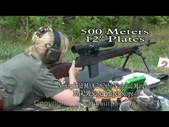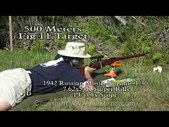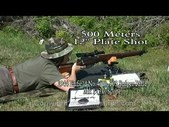-
Legacy Member

NO4 T Accuracy on another forum....link
Someone sent me this link...
http://www.snipercentral.com/no4mk1t.htm
I am interested in the line:..." but it is an accepted fact that the No4 Mk1(T) rifles actually get more accurate the further you go out. You might shoot 3 MOA at 100 meters, but it will likely drop to around 1.5 MOA at 600 meters."
Thoughts?...
Information
 |
Warning: This is a relatively older thread
This discussion is older than 360 days. Some information contained in it may no longer be current. |
|
Thanks ! NickJC North western hills
9-11-01 - In memory of Mom, Loli, Gerry, Donald & Vinny...
-
-
02-21-2011 02:33 PM
# ADS
Friends and Sponsors

-
Ex India rifle with a Mk2/1 telescope too. They had a lot of 2/1's and of the large batch that I rebuilt, there were a lot of 2/1's among them. Most were upgraded to Waterproof spec with the what we called the FEMOD desiccation screw fitted
-
Thank You to Peter Laidler For This Useful Post:
-

Originally Posted by
Nickjc

Someone sent me this link...
http://www.snipercentral.com/no4mk1t.htm
I am interested in the line:..." but it is an accepted fact that the No4 Mk1(T) rifles actually get more accurate the further you go out. You might shoot 3 MOA at 100 meters, but it will likely drop to around 1.5 MOA at 600 meters."
Thoughts?...
Well, take this with a grain of salt and it's just my two cents based upon my wife's and my own personal experience shooting the No.4(T) sniper rifles extensively, all the way out to 600 meters, or roughly 660 yards.
I'm not exactly sure what point the author is trying to make ... 
The principles of long range shooting haven't changed much but the inherent differences in old "full wood" milsurp snipers versus modern "free floating barrel" sniper rifles have. The latter will easily shoot 1 MoA at 600 meters all day and in fact, our personal modern sniper rifles shoot sub 1 MoA at 600 meters, knocking down and nailing the thin necks of bowling pins consistently shot after shot. My wife got bored after 20 or so without missing... 
The math is simple …
1 MoA at 100 yards = 1", so 3 MoA at 100 yards = 3" group ...
1 MoA at 600 yards = 6", so 1.5 MoA at 600 yards = 9" group ...
Sub-MoA at 600 yards = less than a 6" group
My wife's experience shooting all her No.4(T)'s from 100 meters to 600 meters, was that accuracy decreased and size of grouping increased in greater proportion as the distance to the target increased, plus after the 2nd round she fired from a pre-zeroed "cold bore", the accuracy went right in the toilet with barrel heating, which I presume was due to a loss of a tuned barrel harmonics with the barrel pressing against the military bedded wood. If she let it cool down to a "cold bore" again and repeated the shot, it was a again accurate for one or two rounds. This pattern seemed to exist across all her No.4(T)'s and in our opinion, I think any No.4(T) would be awesome if it shot 3 MoA (18" group) at 600 yards, allowing for cool down between shots.
Heat issues haven't been a problem on her (and my own) custom built sniper rifles, which of course have a free floating tuned barrels free floating from receiver to muzzle brake.
Here's a thread with a range report and pics on both of our Custom Built by Milcun (Keith Cunningham) .308 Sniper Rifles
Check out this video of her shooting at 1,000 meters with her custom built .308 sniper rifle.
First round hit at 1,000 Meters (click here)
Also, here's a few related range videos in The Screening Room (click here).
WWII Milsurp Sniper Rifles at 400 Meters (click here)
Milsurp Sniper Rifles at 500 Meters (click here)
This is some fun video, which I thought many collectors here would enjoy. It shows my wife and I, along with our friend Scott, shooting various sniper rifles from our personal collections, including a No.4(T) Turn up the volume so you can hear the sound of those plates dropping! Notice the sound delay between the time you see the plate fall, until you hear the metal PING sound return back up range to the shooter's position.
Engaging 12" Steel Plates and Figure 11 (Man) Targets at 400 and 500 Meters.
1944/45 British Enfield No.4(T) .303
Enfield No.4(T) .303
1942 Russian 91/30 Mosin-Nagant 7.62x54r
91/30 Mosin-Nagant 7.62x54r
1908 Swedish m/41b 6.5mm
m/41b 6.5mm
Springfield M1A National Match 7.62x51
National Match 7.62x51
1909 Argentine Mauser 7.65x53
Mauser 7.65x53
Pics extracted from video...
 (Click PIC to Enlarge)
(Click PIC to Enlarge)
 (Click PIC to Enlarge)
(Click PIC to Enlarge)
Hope this long post somehow helps answer your question … 
Regards,
Doug
Edit: By the way, just for clarity, I never bothered to read the thread you linked to, just responded to your single line question ... 
Last edited by Badger; 02-21-2011 at 04:12 PM.
-
The Following 3 Members Say Thank You to Badger For This Useful Post:
-
-
-
Legacy Member

The word "compensation" comes to mind but I think it only applies to SMLE's, not No.4 rifles. Something about barrel flexing and the position of the muzzle when the bullet exits can make the rifle shoot comparatively better groups at longer distance. Hopefully someone who knows about this will chime in as it could be an interesting discussion topic.
See 1929 "Textbook of Small Arms" bottom of pg. 55.
Last edited by Steve H. in N.Y.; 02-21-2011 at 08:10 PM.
Reason: Added reference.
-
-
Deceased January 15th, 2016


Originally Posted by
Steve H. in N.Y.

The word "compensation" comes to mind but I think it only applies to SMLE's, not No.4 rifles.
In the "old days" at Bisley when 7.62 mm Target Rifles were nearly all converted something elses (no Swings or Metal Mickies in those days.), the received wisdom was that the No.4 was best at the longer ranges (600x plus) due to its inherent "compensation" but P.14s (Mauser action) better at the shorter ranges.
-
I've read similarly re. compensation in Jim Sweets little book "Competitive Rifle Shooting", there used to be a copy in the library on this site, but I think it's been removed as they're selling it again.
For what it's worth, there are regularly No4 T's being shot in scoped (service ) matches at my club, at 200, 300, and 400 meters. Many of these rifles will keep about 50% of the shots within 1 MOA and the rest within 3MOA for 2* 10 shot strings of single tap 4 second exposures.
I havn't seen the groups turn to disaster after 2 or 3 shots typically with these rifles or other well set up No4's.
As another aside, I'm regularly shooting full bore at the moment and I intend to in the future, so I should be able to get some full stages shot with my No4T out to 800m in "F" class, should be interesting, I'll post the results.
Last edited by tbonesmith; 02-22-2011 at 05:22 AM.
-
-
"...I am interested in the line:...' but it is an accepted fact that the No4 Mk1(T) rifles actually get more accurate the further you go out. You might shoot 3 MOA at 100 meters, but it will likely drop to around 1.5 MOA at 600 meters.'
Thoughts?..."
Having shot a few No.4 Mk.1(T)s out to about 700yds, that statement doesn't ring true. The 2 1/2-3 MOA rifles (at 100yds) usually do LESS well as distances increase. The 1 1/2-2 MOA rifles (I don't have a true 1 MOA or better Enfield except possibly the L42a1s , and they aren't ALWAYS-due to operator incompetence- ) either maintain their MOA or disperse an additional 1/2-2 MOA at distance. Only my Trials rifle is REALLY consistant and predictable. All the above assumes reasonable constant conditions. Add variable and/or "switchback" winds and...
Last edited by jmoore; 02-22-2011 at 05:33 AM.
-
-
Advisory Panel


"Compensation" in both No1s and No4s is a real phenomena, and it is analysed in many original Enfield sources.
It is strange to shoot a No4 that only groups 4-5" at 100 yds, and then - with the same ammunition - produces consistent 5s and Vs at 1000yds (approximately 2 MOA and 1 MOA on UK NRA targets).
NRA targets).
Badger, perhaps those 4(T)s need a check over? Although most rifles will send the first round slightly off compared to subsequent shots (oil, cleaning residue, etc), a No4 should continue to group consistently over fairly brisk rates of fire.
-
-
Are the 4-5" groups dispersed vertically or does that apply to any old "pattern"? I can understand the phenomenon if the lowest velocity round hits the highest at "close" range, but a buckshot pattern doesn't seem likely to decrease in dispersion.
-















 PM
PM
















